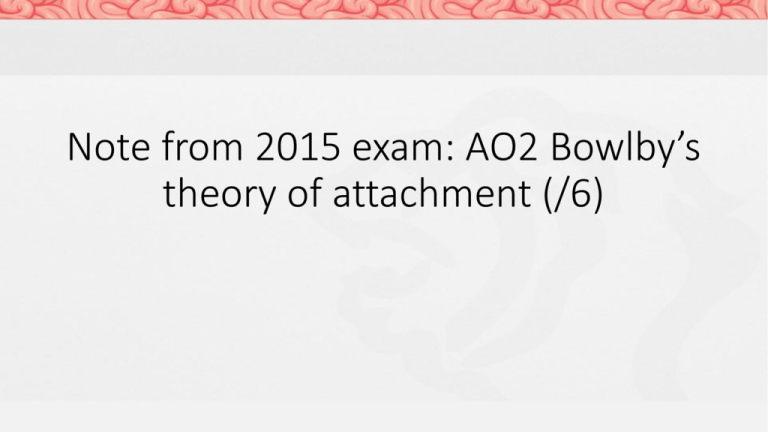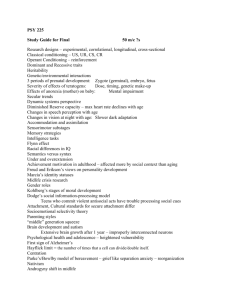Learning Theory
advertisement

Note from 2015 exam: AO2 Bowlby’s theory of attachment (/6) Attachment “Explanations of attachment: learning theory” Attachment: AO1 Describe the Behavioural theory of attachment AO2 Apply classical conditioning procedures to novel scenarios AO3 Evaluate the behavioural theory of attachment by considering research from Harlow etc. Homework: We will be studying 2 explanations of why infants attach: 1. Learning Theory (Dollard & Miller) 2. Evolutionary Theory (Bowlby) The Learning Theory Classical Conditioning (through association) Operant Conditioning (through consequences) Learning Theory Attachment is a set of learned behaviors (i.e. results from experience of the environment, not innate processes) This theory suggests we learn to attach due to the rewards that it provides us with. Therefore attachment is not innate. Classical conditioning: Learning through association Pavlov? Ring a bell? Unconditioned stimulus Neutral stimulus Unconditioned Response (Pleasure) Neutral Stimulus No Conditioned Response Unconditioned stimulus + Neutral stimulus Unconditioned Response (Pleasure) Unconditioned stimulus Neutral stimulus Unconditioned Response (Pleasure) Neutral Stimulus No Conditioned Response Unconditioned stimulus + Neutral stimulus Unconditioned Response (Pleasure) Classical conditioning: Before conditioning Neutral Stimulus No Conditioned Response Classical conditioning: Before conditioning Unconditioned Stimulus Conditioned Response (Pleasure) Classical conditioning: Unconditioned stimulus Neutral stimulus Unconditioned Response (Pleasure) Classical conditioning: During conditioning Unconditioned stimulus + Neutral stimulus And if this is repeated numerous times, a conditioned response is formed So that now in the absence of the food, the pleasure response is elicited when the mother is present… Unconditioned Response (Pleasure) Classical conditioning: after conditioning Conditioned Stimulus Conditioned Response (Pleasure) Does classical conditioning explain why the PRIMARY CAREGIVER also becomes attached? No. Operant conditioning does though.. Operant conditioning Attachment through consequences If a behaviour is reinforced it is more likely to be repeated. Operant conditioning • +ive consequences reinforce behaviours • When child feels hungry & is fed, food gives a feeling of pleasure (primary re-enforcer) • Person who supplies food associated with avoiding discomfort and becomes secondary re-enforcer (& source of pleasure in own right) • Attachment occurs because child seeks person who can supply reward Attachment behaviour is rewarded so they continue doing it/do more of it! Operant conditioning • Infant learns that crying, smiling brings positive response from adults (positive reinforcement) • Adult learns that responding to cries etc. brings relief from noise (negative reinforcement) THINK, PAIR, SHARE How does operant conditioning explain why the PCG (primary care giver) becomes attached? Whiteboards! What psychological approach was responsible for the learning theory? The behaviourist approach Whiteboards! According to the Learning Theory, what are the two main ways in which attachment can be formed? Classical conditioning – through association Operant conditioning – through consequences Whiteboards! What is classical conditioning? Involves learning to associate two stimuli together so that we begin to respond to one in the same way we already respond to the other. Whiteboards! What is operant conditioning? The Learning Theory predicts that: • The child will form attachments on the basis of primary care provision (feeding etc.) • Attachment behavior should increase steadily from birth • The strongest attachments will be with those who provide the most primary care. Harlow How does this experiment support/not support the Learning Theory? https://www.youtube.com/watch?v =_O60TYAIgC4 Harlow • Baby monkeys did not become attached to milk-feeding wire mother monkey • Became attached to cloth wire covered monkey (that didn’t feed them) & sought comfort from it when frightened • Suggests softness, warmth, comfort leads to attachment Evaluation (AO2) These are some summaries of important research findings into attachment. This evidence can be used to evaluate the explanations of attachment and to help us decide what explanation is closest to the truth. Read each research finding and then make notes in answer to the following questions: Does it support the learning theory of attachment? Why/why not? Are there any problems with the research that limit its usefulness? In the 50s and 60s, Harlow conducted a number of studies in which infant rhesus monkeys were separated from their mothers and placed in isolation. In their cages were two artificial ‘mothers’, a wire one that dispensed milk and a soft cloth one that did not. The monkeys spent much of their time clinging to the ‘cloth mother’ and would run to it if startled. Complete Evaluation Worksheet 10 mins Shaffer and Emerson (1964) conducted a large scale observational study of attachment in human infants. They found that infants formed attachments with the adults who were most responsive to them and who provided the most stimulation. In many cases this was not the person who fed and cleaned or spent most time with the child. In many cases, the children formed multiple attachments to the people around them. Fox (1977) studied children being raised in an Israeli Kibbutz, where children are reared communally. From an early age, children lived in a children’s house where they were cared for by a nurse who took care of their daily needs, fed them and so on. They spent only an hour or so each evening with their parents. The children were strongly attached to their parents and showed only relatively weak attachments to the nurses. Hazan and Shaver (1987) surveyed a large number of respondents to a newspaper advert about their romantic relationships and their childhood memories. They found that their romantic relationships tended to echo their memories of their early relationships with their parents. When they remembered their mothers being sensitive and responsive they tended to report secure and happy romantic relationships. Those who had more negative memories of early attachment were more likely to report either being clingy or being distant. ……………………………………………………………………………… ……………………………..……………………………..………………… …………..……………………………..……………………………..…… ………………………..……………………………..……………………… ……..……………………………..……………………………..…………. ……………………………………………………………………………… ……………………………..……………………………..………………… …………..……………………………..……………………………..…… ………………………..……………………………..……………………… ……..……………………………..……………………………..…………. ……………………………………………………………………………… ……………………………..……………………………..………………… …………..……………………………..……………………………..…… ………………………..……………………………..……………………… ……..……………………………..……………………………..…………. ……………………………………………………………………………… ……………………………..……………………………..………………… …………..……………………………..……………………………..…… ………………………..……………………………..……………………… ……..……………………………..……………………………..…………. Evaluation of The Learning Theory Limitations: • SCHAFFER & EMERSON (1964) • HARLOW (1958) • Original Learning Theory uses food to develop the attachment. Strengths • This is a common-sense explanation of attachment, which was assumed to be true for many years. • Evidence suggests that emotional responses can be acquired through conditioning GAME Instructions: Each group will get an envelope. Inside this envelope is a question. Your task is to answer this question with your group, and bring the answer to me. Once you give me the answer and I have checked it, I will give you the next question. Inside each envelope is a letter. Once you’ve collected all envelopes (and letters), you should be able to make a word, name or place. You need to, with the rest of your group (and with the help of your books/textbooks) tell me what that word, name or place refers to. Group 1 Group 2 SEMINAR Read the essay. Give the essay a mark out of 8 SUCCESS CRITERIA FOR LEARNING THEORY ESSAY AO1 • Learning theory suggests attachment develops through classical and operant conditioning. • According to classical conditioning food (UCS) produces pleasure (UCR). • The mother is associated with the pleasure and becomes a conditioned stimulus. • According to operant conditioning food satisfies the infant’s hunger and makes it feel comfortable again (drive reduction). • Food is therefore a primary reinforcer. The mother is associated with food and becomes a secondary reinforcer. • The infant becomes attached to the mother because she is a source of reward. • Candidates may refer to classical conditioning, operant conditioning or both. • The explanation must be directly linked to attachment. Unrelated descriptions of classical or operant conditioning are not credit-worthy. AO3 • Evaluation of learning theory could include reference to research studies such as Schaffer and Emerson who found that less than half of infants had a primary attachment to the person who usually fed them. • Responsiveness seemed to be the key to attachment. • Harlow’s research suggesting the importance of contact comfort rather than food could also be made relevant. • Alternative explanations, such as Bowlby’s evolutionary theory, could gain credit as long as they are used as evaluation and not simply described. • Commentary on implications could be credit-worthy. Level Marks Description 4 7–8 3 5–6 2 3–4 1 1–2 Knowledge of Dollard & Miller’s learning theory of attachment is accurate and generally well detailed. Evaluation is effective. The answer is clear, coherent and focused on formation of attachment. Specialist terminology is used effectively. Minor detail and / or expansion of argument sometimes lacking. Knowledge of Dollard & Miller’s learning theory of attachment is evident. There are occasional inaccuracies. There is some effective evaluation. The answer is mostly clear and organised, with focus on formation of attachment. Specialist terminology mostly used effectively. Knowledge of Dollard & Miller’s learning theory of attachment is present. Focus is mainly on description. Any evaluation is of limited effectiveness. The answer lacks clarity, accuracy, organisation and focus in places. Specialist terminology used inappropriately on occasions. Knowledge of Dollard & Miller’s learning theory of attachment is limited. Evaluation is limited, poorly focused or absent. The answer as a whole lacks clarity, has many inaccuracies and is poorly organised. Specialist terminology, either absent or inappropriately used. No relevant content. 0 SEMINAR 1. Read the essay again 2. Highlight AO1 and AO3 points 3. Turn this into a plan in the AO1/AO3 PEELs. Describe and evaluate the Learning Theory of Attachment (8 marks) AO1 AO3 Theories of Attachment Theories of Attachment H o m e w o r k Dollard & Miller’s learning theory of attachment suggest that attachment is a set of learned behaviours. The basis& for the learning attachments is the Dollard Miller’s learning oftheory of attachment provision of attachment food. An infant initiallybehaviours. form an suggest that is a setwill of learned Dollard & Miller’s learning theory of attachment attachment feeds it.of They learn to associate The basis to forwhoever the learning attachments is the suggest that attachment is a set of learned behaviours. the feeder of (usually withinitially the comfort provision food. the An mother) infant will form of an The basis for the learning of attachments is the being fed and through theit. They process ofto associate classical attachment to whoever feeds learn provision of food. An infant will initially form an conditioning, come to find contact with the mother the feeder mother) comfort of attachment to (usually whoeverthe feeds it. Theywith learnthe to associate comforting. find that behaviours (e.g. being fed They and also through thecertain process of classical the feeder (usually the mother) with the comfort of crying, smiling) bring to desirablecontact responses from others, conditioning, mother being fed and come through find the processwith of the classical and through They the process ofthat classical conditioning learn comforting. also find certain behaviours (e.g. conditioning, come to find contact with the mother to repeatsmiling) these inbring order to get the things they want crying, desirable responses from others, comforting. They also find that certain behaviours (e.g. and through the process of classical conditioning learn crying, smiling) bring desirable responses from others, to repeat these in order to get the things they want and through the process of classical conditioning learn to repeat these in order to get the things they want Bowlby’s evolutionary theory of attachment suggests that children come into the world biologically preprogrammed to formtheory attachments with suggests others, Bowlby’s evolutionary of attachment because this will help them survive. The infant that children come into the to world biologically preBowlby’s evolutionary theory of attachment suggests produces innateto‘social behaviours as programmed formreleaser’ attachments with such others, that children come into the world biologically precrying andthissmiling thatthem stimulate caregiving from because will help to survive. The infant programmed to form attachments with others, adults. Theinnate determinant attachment is not food produces ‘social ofreleaser’ behaviours suchbut as because this will help them to survive. The infant care andand responsiveness. Bowlby suggested that a child crying smiling that stimulate caregiving from produces innate ‘social releaser’ behaviours such as would initially form only one attachmentisand the adults. determinant of attachment not that food crying andThesmiling that stimulate caregiving frombut attachment figure acted asBowlby a secure base forthat exploring care and responsiveness. suggested a child adults. The determinant of attachment is not food but the world. Theform attachment relationshipand actsthat as the a would initially only one attachment care and responsiveness. Bowlby suggested that a child prototype for allacted future social relationships so attachment figure as a secure base for exploring would initially form only one attachment and that the disrupting it can severe consequences. the world. Thehave attachment relationship acts as a attachment figure acted as a secure base for exploring prototype for all future social relationships the world. The attachment relationship acts as a so disruptingfor it can severe consequences. prototype allhave future social relationships so Which of these two theories do youdisrupting find most Why? it can convincing? have severe consequences. Which of these two theories do you find most convincing? Why? Which of these two theories do you find most convincing? Why? ___________________________________________________________________________________________ ___________________________________________________________________________________________ ___________________________________________________________________________________________ ___________________________________________________________________________________________ ___________________________________________________________________________________________ ___________________________________________________________________________________________ ___________________________________________________________________________________________ ___________________________________________________________________________________________ ___________________________________________________________________________________________ ___________________________________________________________________________________________ ___________________________________________________________________________________________ ___________________________________________________________________________________________ ___________________________________________________________________________________________ ___________________________________________________________________________________________ ___________________________________________________________________________________________ ___________________________________________________________________________________________ ___________________________________________________________________________________________ ___________________________________________________________________________________________ ___________________________________________________________________________________________ ___________________________________________________________________________________________ ___________________________________________________________________________________________ ___________________________________________________________________________________________ ___________________________________________________________________________________________ ___________________________________________________________________________________________ ___________________________________________________________________________________________ ___________________________________________________________________________________________ ___________________________________________________________________________________________ ___________________________________________________________________________________________ ___________________________________________________________________________________________ ___________________________________________________________________________________________ Make sure you’re ready for next lesson. You’ll be writing the 8 mark essay without your plan. H o m e w o r k






